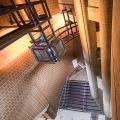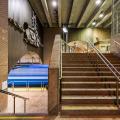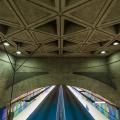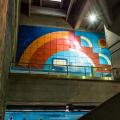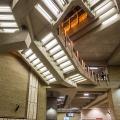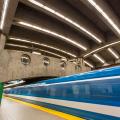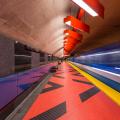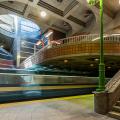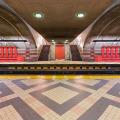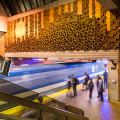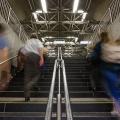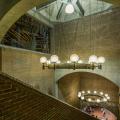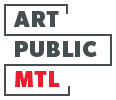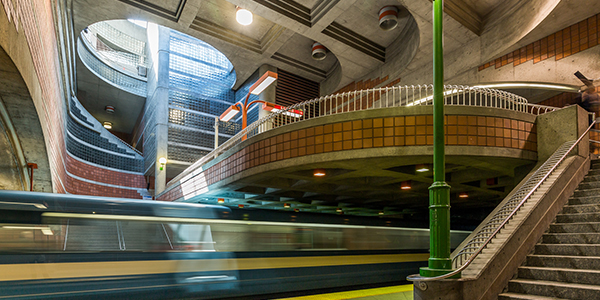
Culture below ground: stations along the Blue line
With photos by Julien Perron-Gagné
The Montréal métro is known around the world for the architectural quality of its stations and its collection of artworks. And you? How well do you know your métro? And, more importantly, have you ever visited the 12 stations along the Blue line, the underground network’s least known, yet most spectacular line? As part of the Journées de la culture, we offered five guided tours of these stations.
You couldn’t attend any of these tours? No problem! Explore the stations along the Blue line on your own, on site or in the following sections!
Architects: LeMoyne & Associés
Artists: Marcelin Cardinal, Charles Lemay, Lauréat Marois & Normand Moffat
Opened: 1986
The two entryways into station Saint-Michel stand on each side of boulevard Saint-Michel, at the corner of rue Shaughnessy, slightly north of rue Jean-Talon. As the Blue line’s east-end terminus, the station’s main entrance building opens onto two floors of waiting areas and all the technical rooms needed for the power supply station. The secondary entrance building connects to the main space via a corridor below boulevard Saint-Michel. The inside space looks like a gigantic cube with staircases in the middle. Walls are covered with square clay blocks; placed next to them are glass blocks of similar size that bring light into the entryways, and see-through surfaces on different levels. Lighting for the interior space is built into an overhead metallic structure, creating quite an original effect.
Architects: Paul G. Brassard & Walter Warren
Artist: Eddy Tardif
Opened: 1986
Station D’Iberville serves an essentially residential neighbourhood. Transit users enter the station either through the main entryway at the northeast corner of Jean-Talon and D’Iberville, or through the secondary entryway at the southwest corner of Jean-Talon and Louis-Hébert. Concrete foundations, brick walls and windows capped by concrete eaves define the architecture for both north and south side entrance buildings. In addition to concrete, brick and anodized aluminium are used on the walls. Granite is used on entryway floors, while ceramic tiles in shades of brown adorn the platforms. Made of resin concrete, seats offer touches of colour here and there.
Architects: Bruno Bédard & Raimondo Averna
Artist: Jean-Noël Poliquin
Opened: 1986
Located below rue Jean-Talon, between Fabre and Papineau, station Fabre features two entryways, one at each end. The station is near a hospital and a number of office buildings, and also serves a residential neighbourhood of average density. Set approximately 13 metres below the surface, the station’s middle section was excavated from the rock. The entrances, as well as most of the transept on the west side, were an open-cut construction. Two large spaces with concrete coffered ceilings make up the two mezzanines, linked by escalators to each entryway. Polymer concrete panels are used as wall finishes, presenting a dynamic element in terms of shapes and colours.
Architects: Duplessis, Labelle & Derome; Gilbert Sauvé (Bureau de transport métropolitain)
Artists: Judith Bricault Klein; Yann Pocreau; Gilbert Sauvé
Opened: 1966 (Orange line); 1986 (Blue line)
Serving the Orange line since the métro originally opened in 1966, station Jean-Talon became a transfer point with the Blue line in 1986, where they intersect, with stacked train platforms, at 18 and 24 metres below the surface. Two wide open spaces were created on each side of the Orange line platforms to facilitate transfers between lines. They also served to maintain the accessibility of exits that predated 1986 and of the corridor leading to the entryway near rue Saint-Hubert. Both large spaces hold three floor levels with wide openings that help people find their bearings. Corridors tunneled from the rock follow the usual vaulted shape. Floors are finished with coloured tiles that matches the adjacent métro line; at the foot of the staircases, the floor tiles’ colour scheme identifies the other line.
Architect: Paul Goyer
Artist: Jean-Charles Charuest
Opened: 1986
Station De Castelnau is located in a mixed commercial and residential neighbourhood, of medium density. The area features a number of attractions, including Jean-Talon Market and Jarry Park. Two entryways welcome transit users, on the southwest and northeast corners of De Castelnau and Saint-Laurent, the latter integrated into an existing building. The main entrance building’s architecture is streamlined, making use of large glass panes. This visual concept is extended down to the platforms thanks to a free-standing staircase, well clear of any nearby walls. Walking down those stairs, passengers can already catch a glimpse of the train platform. Travertine and matching brick are used as wall finishes. Floors are covered with brown and terra cotta ceramic tiles.
Architects: Blouin, Blouin & Associés
Artists: Huguette Desjardins; Claire Sarrasin
Opened: 1987
Station Parc is north of rue Jean-Talon, below avenue Ogilvy. It was integrated into the former Jean-Talon train station, inaugurated back in 1931. The station’s major attraction consists of a triangular skylight that acts as a kaleidoscope. This opening onto the sky, trees, colours and seasons is positioned in such a way as to be appreciated from both outdoors and indoors, made lively by daylight pouring in. The main vault’s structure, built from an open pit, expresses the building’s underground feel, by borrowing the curved shapes of corridors and stations excavated from the rock. Standard lighting is built into the beams. Floors are finished in warm grey stoneware tiles, while the stairs are made of granite.
Architects: Henri Mercier, Pierre Boyer-Mercier & Patrice Poirier
Artists: Jean Mercier; Météore Design; Michel Morelli
Opened: 1988
Station Acadie sits at the corner of boulevard de l’Acadie and avenue Beaumont, where two entryways allow passengers in. Made entirely of concrete and decorated with black granite, limestone and glazed porcelain, this station emphasizes the sudden appearance of light along the path taken by commuters. Shafts of light show up from above in several locations, almost guiding them to the platform or lead them to the exit. These shafts of light provide customers with ever-changing visual effects while they are in the station and give life to the concrete environment. For contrast, glazed porcelain panels bring touches of bold colour.
Architects: Dupuis, Chapuis & Dubuc
Artist: Gilbert Poissant
Opened: 1988
Station Outremont’s only entrance building is on avenue Van Horne, at the corner of avenue Wiseman. An authentic street recreated indoors, the station is defined by a striking sequence of street furniture, with benches, accessories and even a lamp post, gifted by the former city of Outremont. By repeating simple geometric shapes, a connection is made from the entryway to the platforms through the huge skylight, bringing light to passengers on their way down. People move along a series of curves and few steps are needed to reach the shallow depth of the train platforms, only 14 metres below the surface. All floors are finished with pink granite slabs, while the walls feature concrete blocks, along with glass and clay tiles.
Architect: Patrice Gauthier (Bureau de transport métropolitain)
Opened: 1988
Station Édouard-Montpetit occupies the intersection of boulevard Édouard-Montpetit and avenue Vincent-D’Indy. The station’s south entrance also provides direct access to the winter stadium and connects with Université de Montréal’s sports complex (CEPSUM). Two glass-paned, curved entrance buildings welcome passengers on their way to the métro. As the immediate vicinity of both entryways is densely built up, clean, low-key architectural lines were used, with glass walls and discrete landscaping kept at ground level to avoid disrupting the neighbourhood’s urban balancing act. The architect brought in a pink palette throughout the station’s interior design: walls consist of pre-cast slabs made with quartz in a graduated wash of pink, with reddish hues at the bottom gradually lightening up to whitish tones at the top.
Architect: André Léonard (Bureau de transport métropolitain)
Artist: André Léonard
Opened: 1988
Station Université-de-Montréal stands on Université de Montréal campus grounds, bordering on boulevard Édouard-Montpetit, at the head of the moving sidewalk taking you to the university. Facing that boulevard, the main entrance was built into the terrain’s natural slope, blending into the landscape. A secondary entrance at the station’s west end sits at the corner of Lacombe and Louis-Colin. There, a walkway above the tracks serves to connect the secondary entrance to the mezzanine. A skylight, facing the same direction as the existing grassy slope, livens up the central portion of the station. All exposed concrete was sandblasted. Inside, walls are finished with clay blocks from Québec, and floors with terra cotta tiles in natural shades.
Architects: Tétreault, Parent, Languedoc & Associés
Artists: Claude Bettinger; Bernard Chaudron
Opened: 1988
Located at the corner of chemin de la Côte-des-Neiges and avenue Lacombe, station Côte-des-Neiges was entirely dug from rock and finds itself in a densely populated, fully developed urban area. The main entrance, made of glass and granite, was designed as a sculpture by its architect, an easily identifiable urban object that blends harmoniously into its environment. One can also enter the station through the basement of a building that houses a bank, on the southwest side of the intersection. The station’s walls, floors and furniture are made of greyish pink granite from Québec. The surrounding rock bed made it impossible to include a skylight. Under the circumstances, lighting takes on a bigger role; it was designed to fill the underground space with warmth and luminosity.
Architect: Jean-Louis Beaulieu (Bureau de transport métropolitain)
Artists: Jean-Louis Beaulieu; Claude Guité
Opened: 1981 (Orange line); 1988 (Blue line)
Under a four-storey building at the corner of chemin Queen Mary and rue Westbury, station Snowdon also serves as a transfer point between the Orange and Blue lines, with stacked, central platforms. To limit demolition in a densely developed area, the vision for the station was a network of tunnels dug from the rock bed, on two levels. Red clay bricks from Eastern Québec cover all walls and floors, from the building’s exterior down to platform level. Significantly, with this configuration, directional signage is posted on large cubes, at ground level or suspended above, at crossroads of pedestrian traffic.
Partner of
